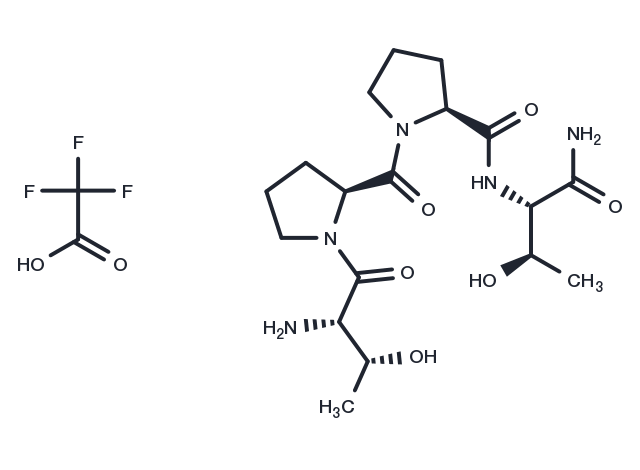Powder: -20°C for 3 years | In solvent: -80°C for 1 year


Rapastinel Trifluoroacetate (GLYX-13 Trifluoroacetate) is an NMDA receptor modulator with glycine-site partial agonist properties.

| Pack Size | Availability | Price/USD | Quantity |
|---|---|---|---|
| 1 mg | In stock | $ 55.00 | |
| 5 mg | In stock | $ 172.00 | |
| 10 mg | In stock | $ 289.00 | |
| 25 mg | In stock | $ 537.00 | |
| 50 mg | In stock | $ 768.00 | |
| 100 mg | In stock | $ 987.00 | |
| 500 mg | In stock | $ 2,080.00 | |
| 1 mL * 10 mM (in DMSO) | In stock | $ 196.00 |



| Description | Rapastinel Trifluoroacetate (GLYX-13 Trifluoroacetate) is an NMDA receptor modulator with glycine-site partial agonist properties. |
| In vivo | Rapastinel Trifluoroacetate, a tetrapeptide (Thr-Pro-Pro-Thr-amide), has been reported to have fast acting antidepressant properties in man based upon its N-methyl-D-aspartate receptor (NMDAR) glycine site functional partial agonism. |
| Animal Research | C57BL/6J mice given a single dose or subchronic ketamine (30 mg/kg.i.p.) showed acute or persistent deficits in NOR, respectively.?Acute i.v. rapastinel (1.0 mg/kg), did not induce NOR deficit.?Pre-treatment with Rapastinel Trifluoroacetate?significantly prevented acute ketamine-induced NOR deficit.?Rapastinel Trifluoroacetate?(1.0 mg/kg, but not 0.3 mg/kg, iv) significantly reversed both subchronic ketamine- and subchronic PCP-induced NOR deficits.?Rapastinel Trifluoroacetate?also potentiated the atypical antipsychotic drug with antidepressant properties, lurasidone, to restore NOR in subchronic ketamine-treated mice.?Unlike ketamine,Rapastinel Trifluoroacetate?does not induce a declarative memory deficit in mice, and can prevent or reverse the ketamine-induced NOR deficit.?Further study is required to determine if these differences translate during clinical use of ketamine and rapastinel as fast acting antidepressant drugs and if rapastinel could have non-ionotropic effects as an add-on therapy with antipsychotic/antidepressant medications. |
| Synonyms | Thr-Pro-Pro-Thr-NH2 Trifluoroacetate, GLYX-13 Trifluoroacetate |
| Molecular Weight | 527.49 |
| Formula | C20H32F3N5O8 |
| CAS No. | 1435786-04-1 |
Powder: -20°C for 3 years | In solvent: -80°C for 1 year
DMSO: 125 mg/mL (236.97 mM)
You can also refer to dose conversion for different animals. More
bottom
Please see Inhibitor Handling Instructions for more frequently ask questions. Topics include: how to prepare stock solutions, how to store products, and cautions on cell-based assays & animal experiments, etc.
Rapastinel Trifluoroacetate 1435786-04-1 Membrane transporter/Ion channel Neuroscience NMDAR iGluR GLYX 13 inhibit GLYX13 GLYX-13 Inhibitor Rapastinel GLYX13 Trifluoroacetate Thr-Pro-Pro-Thr-NH2 Trifluoroacetate Ionotropic glutamate receptors GLYX-13 Trifluoroacetate GLYX 13 Trifluoroacetate inhibitor
